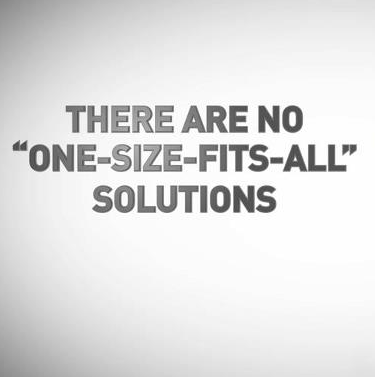Does One Size Fit All In Employee Engagement?

The other day I was approached by a prospective new manufacturing client. They had a robust employee engagement and employee brand program, but for reasons unbeknownst to him, they were not being effective. They were doing all the right things in regard to regular frequent communications, having a message that was aligned with corporate vision and mission, and a decent recognition / reward program which supported appropriate behaviors and innovations. But the programs were not having the impact he and senior management desired. He had hoped for higher employee retention, greater brand ambassadorship and advocacy in higher productivity and efficiency of performance but none of that was happening.
He monitored employee engagement performance with an annual survey of employees but the numbers and scores did not improve year-to-year. They got to the point where he was challenging what he was doing and whether or not his approach was the best way to go.
I started to ask him a few questions. As we were having a conversation it appeared as if a lightbulb had illuminated in his mind. The first question I asked was, “Do you segment your external target audiences?” Of course, he said yes. I next asked him if he used a variety of communications strategies and media platforms to reach that target market? Again, as with most companies, his answer was yes. I then asked, “Well, are you doing the same thing for your internal constituencies?” His response was an astounding no. He said, that he communicated to all of his employees the same way with the same message. I continued to ask more questions, “Do you have an aging population that will be exiting the company in the near future and do you communicate to them as a group? What about your millennial population? How are you addressing them and are you using social networks and mobile apps to connect with them on their terms in a way that they find important and relevant?” Again, his answer was an astounding no.
I explained that this was probably an underlying cause of his problem, and understanding these internal facing strategies would help him to find the answer to his challenge in regard to improving employee brand engagement. A company should not treat their internal constituencies any different from external constituencies. Internal constituencies should be segmented and communicated to in different ways, at different times and with different messages.
The corporate workforce is in transition from an aging baby boomer population to a new millennial population who have different motivations and aspirations in regard to their work and the companies they work for. For instance, baby-boomers tend to be extremely loyal to their employers and have a tendency to work at one or two companies their entire lives. On the other hand, millennials are motivated by personal aspirations and social norms that drive their behaviors and aspirations. They tend to be loyal to causes and their social network more so than the company they work for. They tend to hop around from employer to employer to find meaningful work. Therefore, it doesn’t make sense to communicate to these different constituencies in the same way or with the same message. Other factors are whether or not employees are unionized, multi-channel distribution, and regional distribution of your organization. All these characteristics and demographic traits matter.
When considering developing and employee engagement and internal branding program, here are several things to consider:
- Survey your internal constituencies in a fashion that allows you to measure employee brand engagement with cross-tabular demographic information such as tenure with the company, age, male/female profiles, regions, type of job/work (manufacturing roles versus administrative, etc.), ethnographic and attitudinal information.
- Conduct some informal qualitative focus groups or in-depth interviews with each of the prominent employee groups to understand their priorities, what is important to them and learn what matters and how frequently they want to be communicated to.
- Develop relevant messages that are important and relevant to each of the demographic segments. Make them unique and different yet support the overall communication strategy of the company.
- Allow each constituency to participate in the communications process and become engaged by offering ideas and suggestions that would be relevant to their constituencies and groups.
- Develop an internal communications media plan that meets the needs and habits of each of the constituencies you have identified. Be sure to use new and innovative social media, mobile applications and peer-to-peer communications.
- Lastly track your results by conducting baseline employee engagement studies, such as Inward’s ChangeFX, that allows you to compare and contrast demographic impact and be prescriptive in regard to future communications planning and tactics.
Well there you have it. One employee brand engagement approach to all constituencies DOES NOT work. We are in a new world of mass customization in meeting the needs of individual employees within a larger corporate perspective. If you would like to discuss the best way to address this issue please give me a call.
